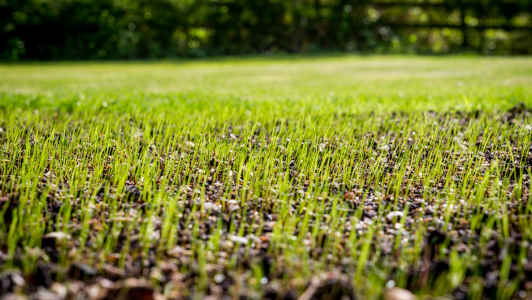Horrifying 'arrowhead' discovery in your own backyard turns into nightmare!
By
- Replies 2
As the Australian summer approaches and temperatures begin to soar, dog owners are urged to stay vigilant about a hidden danger lurking in their backyards.
Vets nationwide are preparing for an influx of sick pets, with a standard garden seed posing a significant threat to our furry friends.
The culprit? Grass seeds, known as awns, can be found in yards throughout Australia as the weather warms up.
These seemingly innocuous seeds can cause severe dog injuries, and many pet owners may not realise the danger until it's too late.
Awns are stiff, hardened bristles that grow from various grasses, such as speargrass, barley grass, wild oats, and cereals.
Their structure is similar to that of an arrowhead, with barbs that only allow them to move in one direction.
Once embedded in a dog's skin, they can burrow deeper through passive movement, causing distressing injuries.
'They're kind of barbed, so they only move in one direction. Like an arrowhead, once they get embedded in the skin, they actually kind of burrow through passive movement,' he explained.
'We've had a few cases where we've ended up with animals in intensive care because the grass seeds have got into the abdomen and caused a perforation or sepsis.'
The health complications from grass seeds can be nasty and often require emergency veterinary care.
Hopkins, who treats several dogs each week for grass seed-related issues, noted that these seeds can migrate around the dog's body.
This sometimes necessitates costly CT scans to locate the foreign body and prevent further damage.
'The main concern is that once dogs get one of these things under their skin, the seed will migrate until they appear somewhere, and that may take months or years,' Hopkins said.
'They can mimic very, very serious conditions, and they are very serious, but people don't associate a grass seed with being that kind of threat...they're just really nasty.'
One harrowing example is the case of a police dog named Bandit, who suffered from septic shock last year after grass seeds were found inside his body.
Bandit survived two surgeries and round-the-clock monitoring but was forced into early retirement from his duties.
Hopkins recommended regular grooming and keeping your dog's fur short, as this reduces the chances of seeds becoming embedded.
Additionally, it's crucial to check your dog for grass seeds after walks, especially during the peak risk period between October and February.
By staying alert and taking these simple precautions, you can help protect your dog from the hidden dangers of awns.
Remember, early detection and removal are vital in preventing these 'nightmare' seeds from causing serious harm to your pet.
 Has your dog shown any signs of trouble after being outside? How do you check for grass seeds? What else can dog owners do to protect their pets from grass seeds? Let us know in the comments below.
Has your dog shown any signs of trouble after being outside? How do you check for grass seeds? What else can dog owners do to protect their pets from grass seeds? Let us know in the comments below.
Vets nationwide are preparing for an influx of sick pets, with a standard garden seed posing a significant threat to our furry friends.
The culprit? Grass seeds, known as awns, can be found in yards throughout Australia as the weather warms up.
These seemingly innocuous seeds can cause severe dog injuries, and many pet owners may not realise the danger until it's too late.
Awns are stiff, hardened bristles that grow from various grasses, such as speargrass, barley grass, wild oats, and cereals.
Their structure is similar to that of an arrowhead, with barbs that only allow them to move in one direction.
Once embedded in a dog's skin, they can burrow deeper through passive movement, causing distressing injuries.
'They're kind of barbed, so they only move in one direction. Like an arrowhead, once they get embedded in the skin, they actually kind of burrow through passive movement,' he explained.
'We've had a few cases where we've ended up with animals in intensive care because the grass seeds have got into the abdomen and caused a perforation or sepsis.'
The health complications from grass seeds can be nasty and often require emergency veterinary care.
Hopkins, who treats several dogs each week for grass seed-related issues, noted that these seeds can migrate around the dog's body.
This sometimes necessitates costly CT scans to locate the foreign body and prevent further damage.
'The main concern is that once dogs get one of these things under their skin, the seed will migrate until they appear somewhere, and that may take months or years,' Hopkins said.
'They can mimic very, very serious conditions, and they are very serious, but people don't associate a grass seed with being that kind of threat...they're just really nasty.'
One harrowing example is the case of a police dog named Bandit, who suffered from septic shock last year after grass seeds were found inside his body.
Bandit survived two surgeries and round-the-clock monitoring but was forced into early retirement from his duties.
Hopkins recommended regular grooming and keeping your dog's fur short, as this reduces the chances of seeds becoming embedded.
Additionally, it's crucial to check your dog for grass seeds after walks, especially during the peak risk period between October and February.
By staying alert and taking these simple precautions, you can help protect your dog from the hidden dangers of awns.
Remember, early detection and removal are vital in preventing these 'nightmare' seeds from causing serious harm to your pet.
Key Takeaways
- Vets warned about the dangers of grass seeds, known as awns, which can seriously injure dogs during the warmer months.
- Grass seeds can cause health complications in dogs, potentially leading to invasive vet procedures to track and remove the seeds.
- A police dog named Bandit suffered septic shock due to grass seeds and had to retire after intensive treatment.
- Owners can protect their dogs by regular grooming and checking for grass seeds, especially between October and February when they are prevalent.








